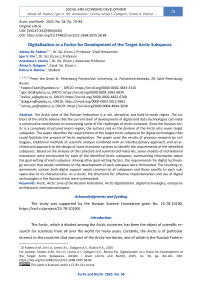Digitalization as a Factor for Development of the Target Arctic Subspaces
Автор: Fadeev A.M., Ilin I.V., Levina A.I., Dubgorn A.S., Rukina P.A.
Журнал: Arctic and North @arctic-and-north
Рубрика: Social and economic development
Статья в выпуске: 58, 2025 года.
Бесплатный доступ
The Arctic zone of the Russian Federation is a rich, attractive, but hard-to-reach region. The authors of the article believe that the current level of development of digital and data technologies can make a constructive contribution to overcoming some of the challenges of Arctic conquest. Since the Russian Arctic is a complexly structured macro-region, the authors rely on the division of the Arctic into seven target subspaces. The paper identifies the requirements of the target Arctic subspaces for digital technologies that could facilitate the process of Arctic exploration. The paper used the results of previous research by colleagues, traditional methods of scientific analysis combined with an interdisciplinary approach, and an architectural approach to the design of socio-economic systems to identify the requirements of the identified subspaces. Based on the analysis of the collected and summarized materials, seven models of motivational extensions were constructed for each of the identified Arctic subspaces, summarizing information about the goal-setting of each subspace. Among other goal-setting factors, the requirements for digital technology services that would contribute to the development of each subspace were formulated. The resulting requirements contain both digital support needs common to all subspaces and those specific to each subspace due to its characteristics. As a result, the directions for effective implementation and use of digital technologies in the Russian Arctic were summarized.
Arctic, Arctic zone of the Russian Federation, Arctic digitalization, digital technologies, enterprise architecture, motivational aspect
Короткий адрес: https://sciup.org/148330877
IDR: 148330877 | УДК: [330.47:332](985)(045) | DOI: 10.37482/issn2221-2698.2025.58.84
Текст научной статьи Digitalization as a Factor for Development of the Target Arctic Subspaces
DOI:
The study was supported by the Russian Science Foundation grant No. 23-78-10190,
The Arctic, which is divided among the Arctic countries, has been the object of scientific research for scientists from all over the world for many years. Certainly, the Arctic is of particular interest to the countries that own part of the Arctic territories, one of which is the Russian Federa- tion (RF). The level of international interest in the Arctic zone is clearly demonstrated by the fact that even countries located in completely different climatic zones (for example, China, Japan, Singapore) have Arctic strategies.
The Arctic zone of the Russian Federation is a region extremely rich in natural resources. The most important Russian Arctic deposits are located in the Republic of Sakha (Yakutia), the Norilsk region, the Kola Peninsula and the Eastern Siberia [1]. Preliminary estimates of hydrocarbon reserves indicate that the Arctic contains 13% of the world’s oil reserves and 30% of the world’s natural gas reserves 1. In addition to minerals, the Arctic zone has unique recreational resources, is a zone of active fishing, and is a unique natural ecosystem. The development of this macro-region is one of the strategic national objectives of the Russian Federation.
To confirm the understanding of the relevance of stimulating research on the development of the Arctic in the Russian Federation, a number of legislative initiatives focused on this zone can be cited. On May 7, 2018, the Decree of the President of the Russian Federation was signed, noting the need to optimize the spatial placement of digital infrastructure in the Arctic zone and in the Far East of the country. The same decree provides a vector for further development of the Northern Sea Route: by 2024, cargo traffic along the Northern Sea Route should reach 80 million tons 2.
In addition, the President of the Russian Federation signed such fundamental documents as the Decree of the President of the Russian Federation of October 26, 2020 N 645, which approves the Strategy for Developing the Russian Arctic Zone and Ensuring National Security until 2035 3, and the Decree of the President of the Russian Federation of March 5, 2020 N 164, which approved the Fundamentals of the State Policy of the Russian Federation in the Arctic for the Period up to 2035 4.
Despite the increased interest in the development of the Arctic zone, this region still remains underdeveloped. This is due to a number of factors that hinder and complicate the organization of human activities in the Arctic: harsh climate, low population density, lack of infrastructure, need to protect nature and biological species living in the Arctic from traces of human activity, high resource intensity of economic activity, as well as the likelihood of geopolitical conflicts arising from determining the ownership of natural resources [2].
Digital technologies can provide an impetus for solving many of the challenges identified above. In addition to ensuring communications in the region, these technologies can replace human labor with machine labor in harsh climatic conditions; information technologies can significantly improve the infrastructure of northern territories, in particular, the use of telemedicine in areas where it is not possible to open stationary medical institutions [3]. In other words, the competent use of digital information technologies can significantly simplify the development of the Arctic, solving or leveling most of the problems listed above.
In order for the use of digital technologies in the development of the Arctic territories to be effective and successful, it is important to take a systematic approach to their application to solve the problems of the region’s development. The purpose of this study is to determine the key areas of digital transformation of the Arctic, as well as to identify the requirements for digital technologies that can be used in the development of the Arctic zone of the Russian Federation.
Literature review
The state of scientific research on existing Arctic development strategies in the world
The issue of Arctic research is relevant and important for all circumpolar countries. Each of these countries has its own views on the development of its Arctic territories, many of them have a developed and adopted program for the development of the Arctic.
As part of the work on this article, an analysis of the programs (in original sources and in scientific reviews) for the development of Arctic territories of the following circumpolar countries was made: Iceland 5, Canada 6, Finland 7, the USA 8, Sweden 9. A review of documents and scientific papers [4]–[10] allowed drawing the following conclusions about the key methods for the development of Arctic territories in circumpolar countries:
-
1. Regardless of the size of the Arctic part of the country’s territory, each of the circumpolar countries notes the forced need to develop their northern territories with the help of modern technologies (and, accordingly, the development of the use of these technologies in the north), since in some places only they make it possible to reach remote territories.
-
2. Delivery of social benefits to the population living in the northern territories and equalization of the level of provision of the population with social benefits within the country (including in the Arctic territories) occupy a rather important place in the strategies for the development of
-
3. There is a need to develop infrastructure in the northern regions of circumpolar countries for life and tourism: in some countries, it is planned to create reliable network communications in order to make navigation in the region and tourism activities safer. At the same time, it is planned to use the collection of climate data and cloud computing to determine the timing of the navigation period in the region more accurately, making the Arctic territories more attractive from logistical and economic point of view.
-
4. The last obvious common feature in the Arctic development strategies of circumpolar countries is sustainable development and “green” production. All Arctic countries note the importance of preserving Arctic nature in its original form and plan to use advanced production technologies for this purpose. For example, with the help of the Internet of Things (IoT), it is planned to flexibly manage harmful emissions from enterprises, reducing them to minimum.
the Arctic territories of circumpolar countries. The authorities of circumpolar countries promise to solve the problem of delivering vital social benefits to remote northern regions with the help of high-speed Internet and digital technologies [11]. For example, the problem of the availability of medical services is partly planned to be solved with the help of telemedicine.
Summarizing the above-mentioned general trends in the Arctic development strategies of circumpolar countries, it can be concluded that the governments of Arctic countries consider digitalization of the Arctic territories to be a fundamental factor in their development.
Relevance of digitalization projects for the Arctic Zone of the Russian Federation
The Russian Arctic is an extremely resource-rich region. According to experts [12], the Arctic zone belonging to Russia contains 52% of all Arctic oil and gas reserves, and the total resource reserves of the Russian part of the Arctic exceed 510 billion tons of oil equivalent. Speaking about the distribution of hydrocarbons in the Russian Arctic, the authors of the monograph “The Arctic Space of Russia in the 21st Century: Development Factors, Management Organization” note that according to preliminary expert estimates, the Russian Arctic shelf alone contains approximately 100 billion tons of oil equivalent [13]. However, despite this great potential, the shelves currently remain less studied compared to the onshore oil and gas-bearing territories [12].
In many respects, the study of these territories is complicated by difficult conditions. Summarizing the published materials [13]–[16], the following factors can be listed: low temperatures, high humidity, salt water, permafrost, lack of solar energy, the presence of ice that impedes navigation in the region, the need to take measures to protect nature and Arctic biological species from traces of human activity, the need to reconcile the cultural and value aspirations of the indigenous population with production activities, high resource intensity of the organization of economic activity, lack of infrastructure for organizing the lives of workers in mining and processing enterprises in the Arctic region, including access to medical care.
A number of Russian scientists see the digitalization of the Arctic as a potential solution to these problems. For example, in the article [17], the authors analyze the outflow of population from cities and settlements in the territories of the Far North and the reasons for this outflow. The authors, using the example of urban communities of Murmansk and the tools described in the article, identified the top reasons why the northern territories of the Russian Federation are difficult to populate: natural and climatic conditions, quality of life (provision of social benefits) and the apparent lack of prospects for the development of the city. In order to correct the picture of demographic population decline, the authors give recommendations to municipal authorities on making changes to city management and introducing new technologies in the development of urban and regional territories. One of such technologies could be digital solutions in various spheres of life of residents of the Far North, which will improve living in these territories and will make it more attractive for people.
It is quite obvious that it is impossible to develop industry, especially in the Far North, without qualified personnel. Employers of infrastructure and processing facilities beyond the Arctic Circle in the territory of the Russian Federation note an acute shortage of personnel in the field of industrial digitalization. Researchers [18] analyzed trends in the training of industrial specialists and surveyed employers in the territories of the Far North of the Russian Federation. In their article, the authors came to the conclusion that employers are ready to implement digital technologies at their facilities, but, unfortunately, they lack personnel for such large-scale projects. This study is a good illustration of the current stage of the process of implementing digitalization at enterprises in the Far North of the Russian Federation — economic efficiency has been proven, plans have been made, and personnel are being trained to implement them. According to recent data [18], companies operating in the Far North are actively signing contracts for targeted training of their future digitalization specialists in higher education institutions.
Another interesting example of the impact of digitalization on settlements and cities in the Far North of the Russian Federation can be the case discussed in the article [19]. In this work, the author considers the case of Norilsk as a single-industry town in the Far North in the context of growth, development and radical changes that can turn it into a city of federal significance. As the author notes, this transformation cannot occur without the widespread implementation of digitalization in all spheres of life of residents. The use of the Internet of Things (IoT), artificial intelligence (AI) and other advanced information technologies will help to achieve “unity of transformation of external, agglomeration connections and internal connections in the economy”, which in turn will ensure the achievement of “centrality” for Norilsk [19].
Russian scientists note the relevance of digitalization and its technological solutions not only in the demographic and urban areas of the Russian Far North. The authors [20] note the importance of skills related to the use of digital technologies and artificial intelligence among applicants of the labor market in the region. In the article [21], the authors note the emergence in recent years of such a phenomenon as smart tourism, which is becoming popular in the Arctic region. The peculiarity of such “smart” tourists, who have recently appeared as a completely new category in the tourist flow, is the active use of predominantly digital communication channels. In this regard, when talking about the development of tourism in the Arctic region, it would be quite logical to focus on the development of digital infrastructure.
A final example of the use of digitalization in the development of Arctic territories is the creation of digital twin of the Arctic population [22]. Having data from the population census of the Arctic regions of the Russian Federation, the authors of the work created an analytical dashboard that can be used to forecast the demographic situation in the cities and regions of the Arctic region of the Russian Federation. The usefulness of this website with analytical functionality does not need to be proven. As the authors note in their article, their product can be used at both the municipal and federal levels to plan measures for the development of the northern territories of the Russian Federation.
The development of the Arctic is a strategically important task for the Russian Federation. During the entire period of research, scientists have considered different approaches to the development of the Arctic region, and it is important to note here that the Arctic as a region is highly heterogeneous. In order to be able to come to applied results in research, it is necessary to segment the region in question.
This study uses the approach proposed by the St. Petersburg Polytechnic University’s scientific school in the field of Arctic research under the leadership of N.I. Didenko and D.F. Skripnyuk, which consists in dividing the territory of the Russian Arctic into target subspaces [23]–[25]. In this case, subspaces are understood as a part of the Arctic space that has distinctive properties that, in turn, allow for the functional division of the Arctic territory into its constituent parts. Each subspace is described by its own development goals [23].
According to [23], it is possible to distinguish the following subspaces within the Russian Arctic:
-
• base cities — large and medium-sized industrial and populated areas;
-
• mobile shift camps — one of the possible ways of developing Arctic territories, especially those where it is impossible to establish a permanent place of residence;
-
• territories of mineral resource extraction — developed deposits and industrial facilities associated with the processing of mineral resources;
-
• territories allocated for fishing purposes — infrastructure for industrial fishing, as well as territories where industrial fishing is carried out;
-
• territories of recreational focus — tourist attractions of the Arctic region;
-
• Northern Sea Route — a shipping route in the Russian part of the Arctic, which also
passes through the territorial waters of Denmark, Canada and the USA;
-
• infrastructure for the protection of safe existence — a subspace that performs the functions of protection and development of the Arctic region, ensures the strategic development of the Arctic.
Results
The formation of requirements for digital technologies for the selected subspaces will be based on the concept of enterprise architecture. This concept can be applied not only to enterprises, but also to any socio-economic systems — industries, institutional environments, regions, states.
Enterprise architecture is understood as a set of various elements that, in the process of their interaction, make up the internal structure of business management, starting from strategy, goals and business models and ending with business processes, technological processes, organizational structure, IT infrastructure, information systems and production equipment [26; 27]. The enterprise architecture concept allows the requirements of the processes implemented in the system to be aligned with the IT and digital technologies supporting them by forming requirements for these technologies and providing services in response.
In this paper, the concept of motivational expansion from the architecture approach will be used. Motivational expansion allows formalizing the goal-setting of the socio-economic system under consideration through the interrelated description of certain elements [26]. Their description is presented in Table 1.
-
Table 1
Elements of the Archi model
|
Element |
Definition |
Designation in the Archi model |
|
Stakeholder (interested party) |
Reflects the role of the person, team or organization that has an interest(s) in the effects of the architecture. |
Stakeholder CD |
|
Driver |
Represents the condition that motivates an organization to define its goals and make the changes necessary to achieve them. |
Driver ^ j |
|
Goal |
Presents a high-level statement of intent or desired end state for the organization and its stakeholders. |
Goal |
|
Requirement |
Defines a required feature that applies to a particular system. |
Requirement |
|
Constraint |
Reflects a factor that limits the achievement of goals. |
Constraint ГП |
-
1. Stakeholders — main interested parties of a given subspace.
-
2. Drivers — external or internal conditions that motivate defining the goals of subspace development.
-
3. Goals — desired final state of the subspace.
-
4. Requirements — necessity that determines the attribute that a given subspace should have.
-
5. Constraints — factors that limit the implementation of goals for a given subspace.
Defining the elements of the motivational expansion of each target subspace and modeling their relationship contributes to the formation of requirements for digital technologies that can facilitate the development of the Arctic region.
The results of the analysis of information on the subspaces of the Arctic zone of the Russian Federation — the drivers of their development, their goal setting, constraints — can be summarized in the form of models of motivational expansions — Figs. 1–7.
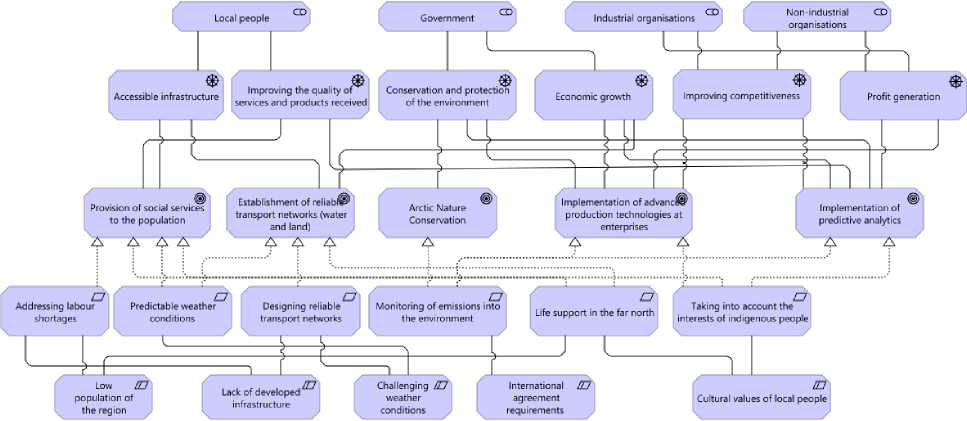
Fig. 1. Motivational expansion “Base cities”.
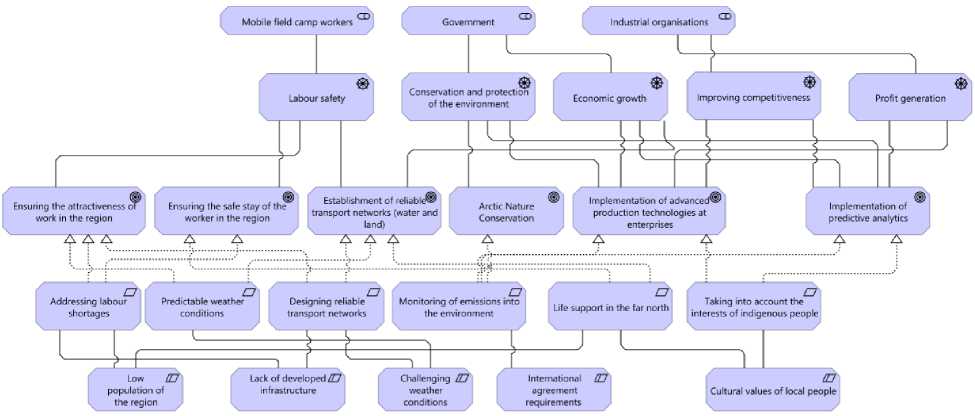
Fig. 2. Motivational extension “Mobile shift camps”.
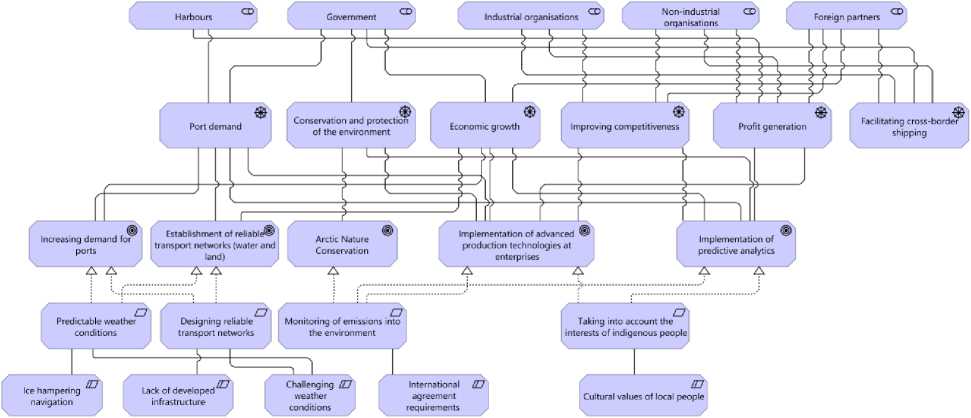
Fig. 3. Motivational extension “Northern Sea Route”.
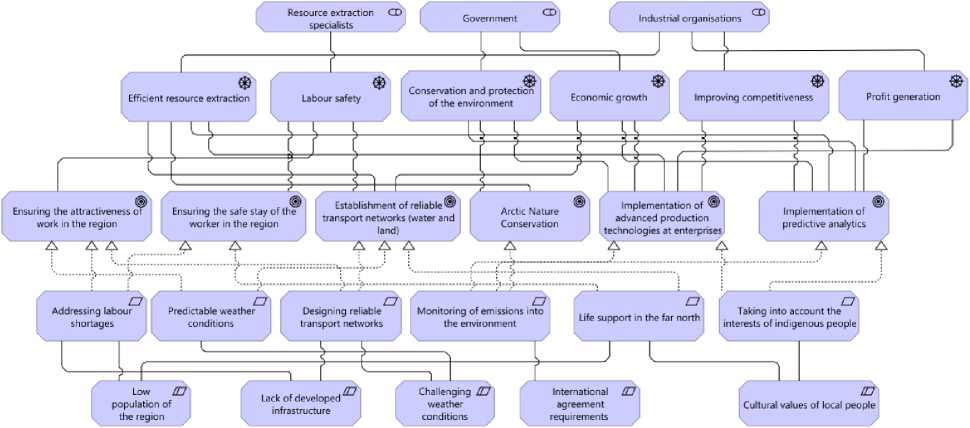
Fig. 4. Motivational extension “Territories of mineral resource extraction”.
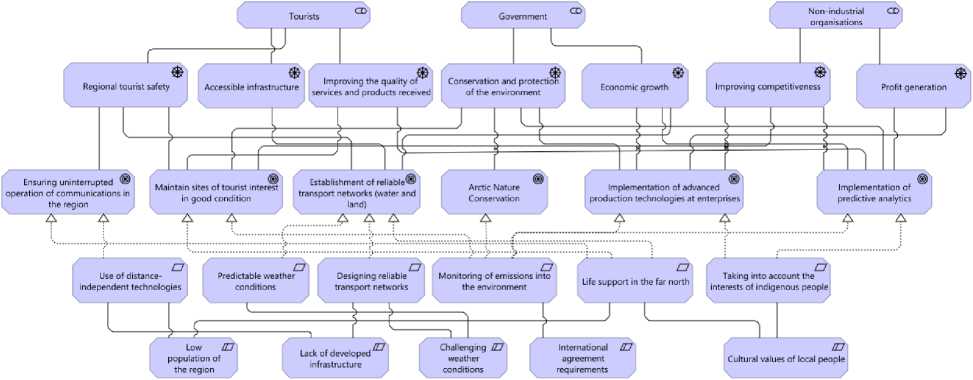
Fig. 5. Motivational extension “Territories of recreational focus”.
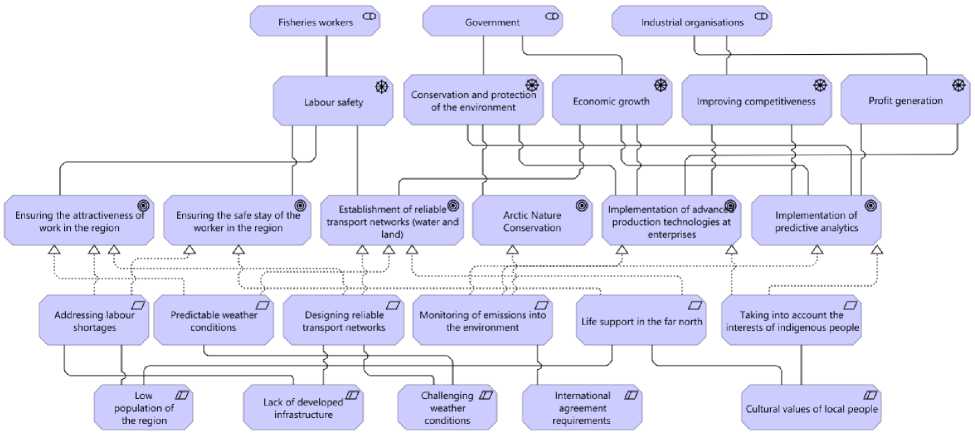
Fig. 6. Motivational extension “Territories allocated for fishing purposes”.
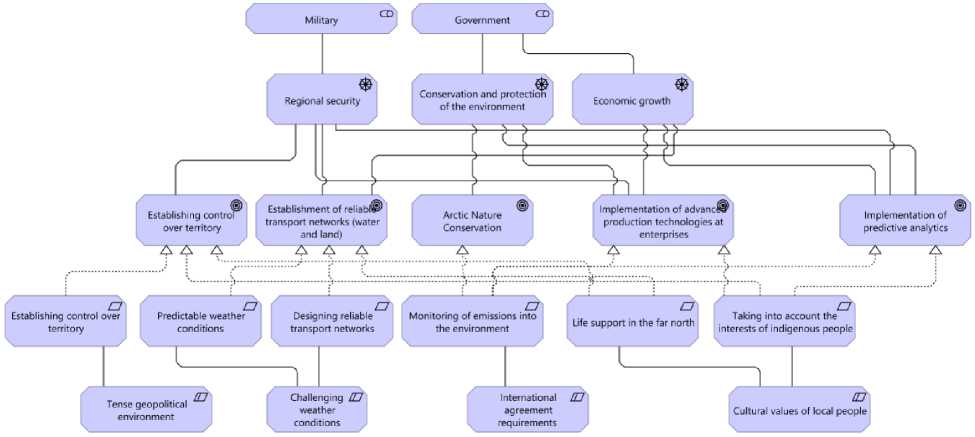
Fig. 7. Motivational extension “Infrastructure for the protection of safe existence”.
Analyzing the obtained models, one can notice an objective similarity of the motivational expansions of the subspaces under consideration. This similarity can be explained by a number of reasons. The most obvious of them is the climatic conditions. The Arctic is a region with undeniably harsh natural conditions that impose their own imprint on any sphere of activity in the region. Each of the subspaces under consideration is identified as part of the Russian Arctic and, accordingly, this subspace should develop and exist in the extreme conditions of the Far North, which should be reflected in each model of motivational expansion.
Another common limitation, the existence of which should also be taken into account when building a development strategy for each of the Arctic subspaces, is the strong emphasis on intergovernmental agreements and Russian regulatory legal acts in the field of preserving the Arctic nature, minimizing human impact on it and counteracting climate change. In modern realities, all socially responsible governments understand and take into account the “green” agenda, build plans for the development of their regions taking into account environmental protection.
These models have also in common the need to take into account the interests of the local and indigenous population of the Arctic region, as well as the fact that the state is directly interested in the development of each of the seven subspaces.
At the same time, the models have a number of notable differences. The first and most important difference of these motivational expansions for the identified seven subspaces is the stakeholders. It is logical that their composition will change from subspace to subspace, since, for example, manufacturing enterprises will be less interested in the development and maintenance of tourist infrastructure facilities in good condition. Similarly, foreign partners do not have a commercial or any other direct interest in the pace of development of social services for the local population of the Russian Arctic.
In addition, some goals and drivers for different subspaces are of equal importance, for example: preservation and protection of the environment and preservation of the Arctic nature, economic growth, implementation of predictive analytics, and application of advanced production technologies in enterprises.
Based on the obtained models of motivational expansions for the seven subspaces of the Russian Arctic and the compiled list of digital technologies applicable in the development of Arctic territories, the following requirements for digital technologies that can simplify human exploration and stay in the Arctic region and work in the harsh conditions of the Far North can be formulated:
-
1. Remote provision of social services (telemedicine technologies, 5G). These technologies will ensure the satisfaction of the population’s need for medical care and will make staying in the Arctic region safer for people.
-
2. Real-time data collection (IoT and IIoT, M2M). Providing real-time data, it is possible to form a reliable pool of information on the current state of infrastructure and technical systems in operation, as well as information on weather conditions.
-
3. Data analytics with visualization and forecasting capabilities (Big Data, AI, BI, cloud computing). Having reliable data obtained using technologies from paragraph 2, this technology will facilitate the implementation of data-driven management, which will ensure rational decisionmaking when ensuring the functioning of subspaces.
-
4. Efficient resource extraction without environmental impact (robotisation of production, digital twins, cyber-physical systems (CPS)). With the help of these digital technologies, it will be possible to model the structure of boreholes in oil and gas bearing regions, which will make the process of hydrocarbon extraction more predictable and safe.
-
5. Security (blockchain). In the development of the Russian Arctic, security (of living, working, and the region as a whole) plays a rather important role. Undoubtedly, it is very important to ensure not only physical security, but also information security (prevention of data leaks, data falsification, etc.).
Conclusion
The programs for the exploration and development of the Russian Arctic have always been a high priority for the Russian Federation. The Arctic is an incredibly rich and at the same time difficult to develop region. The current stage of development of digital and data technologies can contribute to combating the challenges of this region: what is beyond human capabilities can be achieved by remote data exchange technologies, remote control, and efficient analysis and forecasting technologies.
In the course of this study, the theory of dividing the Russian Arctic into target subspaces was used to structure the task of determining the requirements for digital technologies that can simplify human development of the Arctic. The generated models of motivational expansions for each Arctic subspace made it possible to clearly demonstrate the chain from the specifics of the subspace to its needs for digital services. After analyzing the individual requirements of the subspaces, the commonality of these requirements was formulated. It is important to consider the subspaces of the region and the digital infrastructure created for them as a whole. In case of uneven development, technologically less developed subspaces will not be able to interact effectively with technologically more advanced subspaces, and therefore the desired synergistic effect will not be observed.
The following general business requirements for digital technologies in demand in the development of the Arctic were identified:
-
• ability to provide social services to the local population and tourists remotely;
-
• collection and transmission of data in real time from subspace objects;
-
• data analytics with the ability to visualize and forecast;
-
• ability to control machines and units remotely;
-
• effective geo-navigation and meteorological systems.
Satisfaction of each of the formulated consolidated requirements implies the development of digital complexes that include a wide range of digital and data technologies. The conducted research to identify requirements is the basis for further work, including the following steps:
-
• determining the current state of satisfaction of subspaces in digital services;
-
• designing digital complexes that meet the general and individual requirements of Arctic subspaces;
-
• determining the gap between the current and target states;
-
• forming a set of stable and effective intermediate plateaus when moving towards the target state;
-
• developing a roadmap for the development of digital infrastructure in the Arctic zone of the Russian Federation, detailed in the form of a plan of specific project programs.

